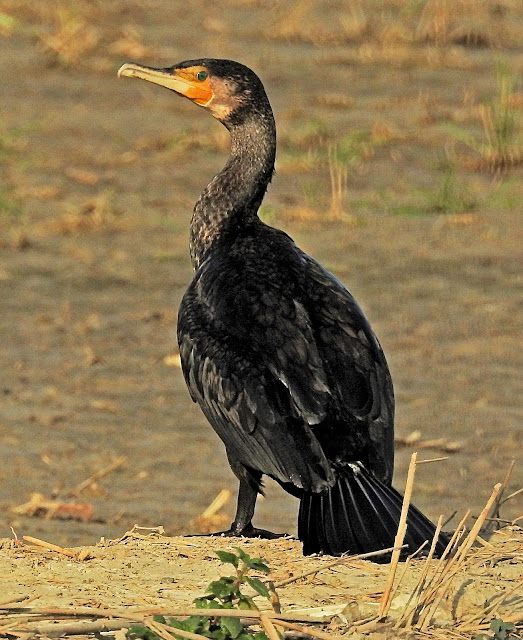The Nicobar pigeon or Nicobar dove (Caloenas nicobarica, Car: ma-kūö-kö[3]) is a bird found on small islands and in coastal regions from the Andaman and Nicobar Islands, India, east through the Indonesian Archipelago, to the Solomons and Palau. It is the only living member of the genus Caloenas alongside the extinct spotted green pigeon and Kanaka pigeon, and is the closest living relative of the extinct dodo and Rodrigues solitaire.
It is a large pigeon, measuring 40 cm (16 in) in length. The head is grey, like the upper neck plumage, which turns into green and copper hackles. The tail is very short and pure white. The rest of its plumage is metallic green. The cere of the dark bill forms a small blackish knob; the strong legs and feet are dull red. The irises are dark.
%2012.jpg)
Females are slightly smaller than males; they have a smaller bill knob, shorter hackles and browner underparts. Immature birds have a black tail and lack almost all iridescence. There is hardly any variation across the birds' wide range. Even the Palau subspecies C. n. pelewensis has merely shorter neck hackles, but is otherwise almost identical.
It is a very vocal species, giving a low-pitched repetitive call.
On the Nicobar Islands (which are referred to in its common and scientific names), the most significant colony of Nicobar pigeons in modern times was found on Batti Malv, a remote wildlife sanctuary between Car Nicobar and Teressa. The 2004 Indian Ocean tsunami caused massive damage on the Nicobar Islands, and to what extent Batti Malv was affected is still not clear. But while everything on some islets in the Great Nicobar Biosphere Reserve was destroyed, Batti Malv lighthouse – a skeletal tower a dozen metres high, standing a few metres ASL at the highest point of the low-lying island – was little-damaged and put back in operation by the survey ship INS Sandhayak less than one month after the disaster. An April 2007 survey by the Indian Coast Guard vessel ICGS Vikram found the lighthouse tower "totally covered" in vines, indicating rampant regeneration of vegetation – but perhaps also that damage to the island's forest was severe, as a cover of creeping plants is typical of early succession stages, while a photo of the lighthouse taken before the tsunami shows rather mature forest.
%2014.jpg)
The Nicobar pigeon's breeding range encompasses the Andaman and Nicobar Islands of India, the Mergui Archipelago of Myanmar, offshore islands of south-western Thailand, Peninsular Malaysia, southern Cambodia and Vietnam, and many of the small islands between Sumatra, the Philippines and the Solomon Islands. On Palau, the only distinct subspecies C. n. pelewensis is found.
The Nicobar pigeon roams in flocks from island to island, usually sleeping on offshore islets where no predators occur and spends the day in areas with better food availability, not shying away from areas inhabited by humans. Its food consists of seeds, fruit and buds, and it is attracted to areas where grain is available. A gizzard stone helps to grind up hard food items. Its flight is quick, with regular beats and an occasional sharp flick of the wings, as is characteristic of pigeons in general. Unlike other pigeons, groups tend to fly in columns or single file, not in a loose flock. The white tail is prominent in flight when seen from behind and may serve as a sort of "taillight", keeping flocks together when crossing the sea at dawn or dusk. The young birds' lack of a white tail is a signal of their immaturity clearly visible to conspecifics – to an adult Nicobar pigeon, it is obvious at a glance which flockmembers are neither potential mates, nor potential competitors for mates, nor old enough to safely guide a flock from one island to another.
This species nests in dense forest on offshore islets, often in large colonies. It builds a loose stick nest in a tree. It lays one elliptical faintly blue-tinged white egg.
In 2017, several individual Caloenas nicobarica were sighted in the Kimberley region of Western Australia with a juvenile captured at Ardyaloon (One Arm Point), near Broome - the first time the bird has been sighted on the Australian mainland.

















%2020.jpg)
%2021.jpg)
%2022.jpg)
%2020.jpg)


%2021.jpg)
%20(Gallinula%20chloropus)%2020.jpg)

%20(Alcedo%20atthis)%2020.jpg)
%20(Alcedo%20atthis)%2021.jpg)

%2010.jpg)
%2011.jpg)
%2010.jpg)
%2011.jpg)
%2012.jpg)
%2014.jpg)
%2010.jpg)
%2010.jpg)


%20(Turdus%20merula)%2020.jpg)
%20(Turdus%20merula)%2021.jpg)
